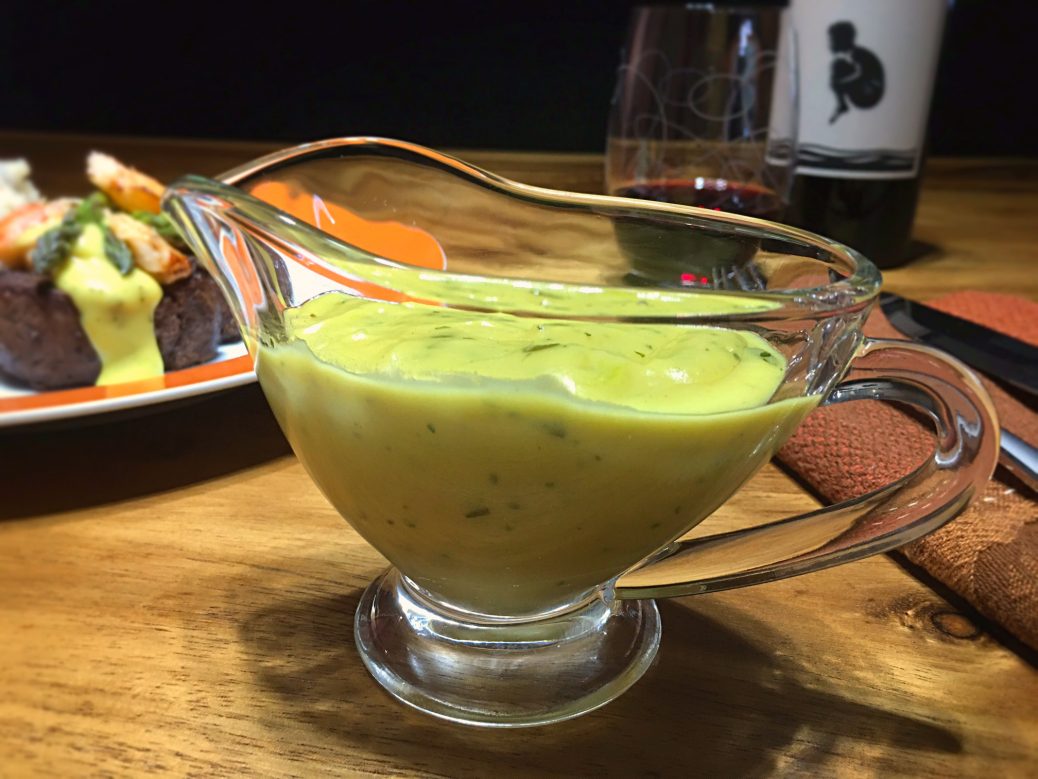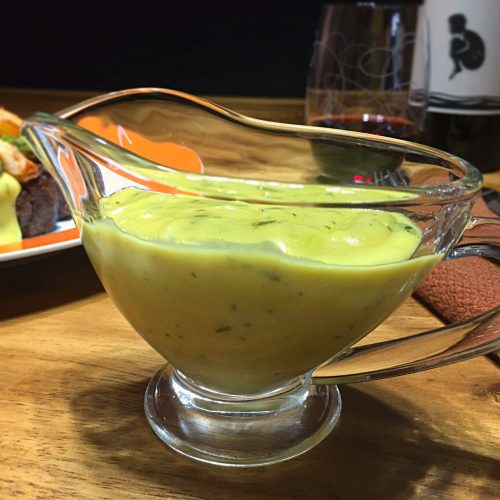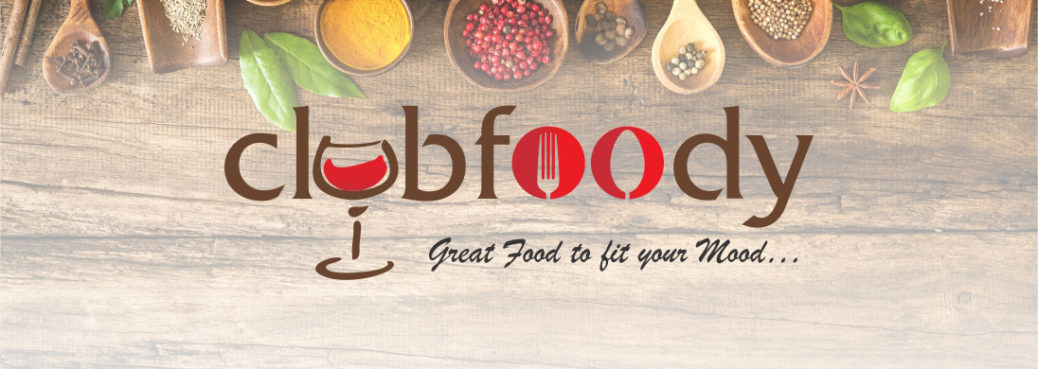Béarnaise Sauce

Do you remember the 5 Mother Sauces of French Cuisine 🤔? I’m sure you do but let’s recap…
– Béchamel and its secondary sauces are Mornay, Nantua, Cheddar Cheese, Écossaise, and Soubise.
– Velouté and its secondary sauces are Suprême (derivative sauces – Albuféra, Creamy Mushroom, Aurore), Normande/Normandy, and Allemande (derivative sauce – Poulette). Other sauces under the umbrella of Velouté are Bercy I, Hungarian, Vénétian and Cardinal.
– Espagnole and its secondary sauces are Demi-Glace (derivative sauces – Marchand de Vin, Lyonnaise, Robert, Mushroom, Charcutière, Bercy II, Madeira, Chasseur, and Port Wine), Africaine and Bigarade.
– Tomate and its secondary sauce are Créole, Provençale, Spanish, Algérian, and Portugaise.
– Hollandaise and its secondary sauces are Béarnaise (derivative sauces – Choron, Paloise, Foyot and its derivative sauce Colbert), Mousseline, Maltaise, Noisette, Bavaroise, Crème Fleurette, Royal, and Moutarde (aka Dijon or Girondine).
In this episode, we’ll focus on one of the Hollandaise secondary sauces… Béarnaise Sauce!
In the past, I showed you how to make this easy classic mother sauce. After emulsifying the egg yolks with some lemon juice and butter 🧈, and then seasoning with salt & pepper, this sauce is pretty much done. The Béarnaise Sauce on the other hand has the foundation of the primary one except dry white wine, white wine vinegar, shallots and tarragon are added. Like the Hollandaise, it’s slightly technical but definitely not complicated.
What to serve with Béarnaise Sauce?, you ask. The most obvious to pair with it is a nice grilled steak along with some mashed potatoes and vegetables. Another dish that I find extremely delicious is when I sear a nice salmon fillet or swordfish. Chicken Pontalba and Chicken Rochambeau are two more tasty recipes the sauce can be used in. Also nothing is stopping you from spooning this incredible sauce over some steamed asparagus or broccoli 🥦 as well as boiled potatoes…
There are derivatives from Béarnaise Sauce which are Foyot, Paloise, Colbert, and Choron. With diverse ingredients, each sauce pairs well with certain dishes. For example; to make Paloise, mint is substituted for the tarragon which goes beautifully with lamb while tomato purée replaces the tarragon for the Choron Sauce and is an excellent match for poultry and fish 🐟.
Béarnaise Sauce goes perfectly with a grilled steak 🥩 but don’t let yourself use it strictly for that. This aromatic sauce is also perfect on fish, eggs, grilled or steamed vegetables, and so on. Grab your favorite whisk and make this gorgeous sauce to enhance your food…
Bon Appétit!🍽
Check out these other delicious sauce recipes…😀
– Steak au Poivre (Steak with Peppercorn Sauce)
– Enchilada Sauce
– Iguana’s Mushroom Sauce
– Indonesian Peanut Sauce
– Caribbean BBQ Sauce
– Romesco Sauce
– Pork Chops with Spicy Peach Sauce
and for even more sauce recipes, click on this link… Recipe Category • Sauces & Marinades
Don’t forget to subscribe to our YouTube channel 📽 by clicking on this link… Club Foody YouTube

Béarnaise Sauce
Hover to scale
Ingredients
INFUSED WINE
- 1/2 cup shallots, finely sliced (Lyonnaise cut) tips & tricks
- 1/2 cup dry white wine such as Chardonnay or Pinot Grigio
- 1/4 cup white wine vinegar (substitute Champagne vinegar)
- 2 large sprigs tarragon tips & tricks
- 1 tsp. mixed peppercorns
SAUCE
- 4 large free-run egg yolks
- 1 pinch ground Himalayan pink salt, or to taste
- 3/4 cup lukewarm butter, melted
- 1 tsp. freshly squeezed lemon juice tips & tricks
- 1 tbsp. fresh tarragon, finely chopped
- 1 tsp. lukewarm water, if needed Footnote
Directions
INFUSED WINE
- In a medium saucepan, add shallots, white wine, white wine vinegar, tarragon and peppercorns; stir well. Bring the mixture to a boil, reduce the heat to medium and simmer until it reduces to about 3 to 4 tbsp., about 15 minutes.
- Remove from the heat and strain the mixture through a fine sieve sitting over a small bowl, pressing on the solids to extract as much liquid as possible; set aside.
SAUCE
- In another medium saucepan, add yolks and whisk very well until they get thick, about 1 minute.
- While whisking, pour in the white wine reduction.
- Set the heat to medium and season a little bit with salt. While whisking constantly, keep lifting the saucepan off the heat - the trick here is to not shock the yolks by gradually heating them up.
- When the custard gets thick, move the saucepan away from the heat and whisking continuously, start adding the melted butter, pouring in a few drops at first – remember don’t shock the yolks! Gradually add more until it’s all incorporated.
- Add lemon juice and fresh chopped tarragon; whisk into the mixture. Taste and adjust the seasoning if needed. If the sauce gets too thick, add about half a tablespoon of lukewarm water to thin it out.
- If not using it right away, move to the back burner, keeping the sauce warm on very low temperature. To prevent skin formation, place a piece of wax paper on top, making sure it touches the surface.
Notes
Don't forget to rate and comment on this recipe!




Absolutely fantastic explanation of the process.
Hello Sean 😀 Thanks very much for your kind comment 🙏. Happy to hear you enjoyed the video! Have a great day 🌞